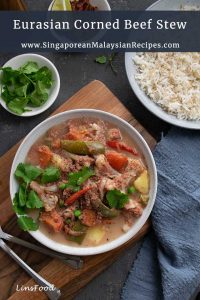Ayam Assam Serani is a delicious curry of the Eurasian persuasion, from Singapore and Malaysia, with tangy, earthy and salty flavours.
Estimated reading time: 4 minutes
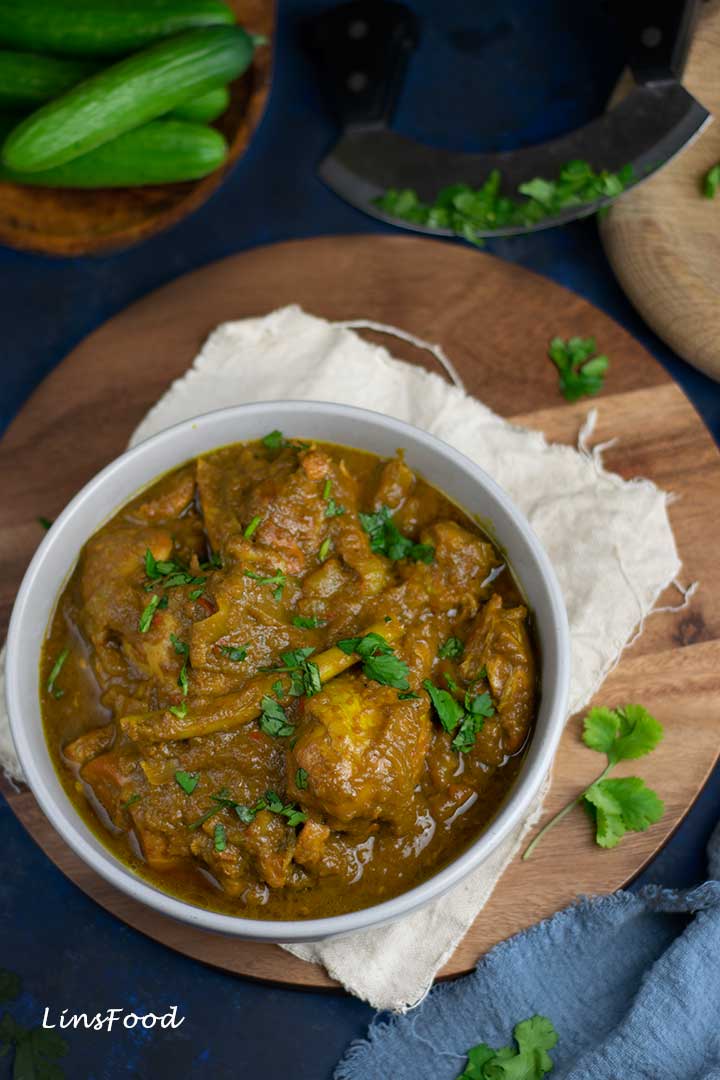
Ayam Assam Serani
Let’s take a look at the name, because you really need to know what that recipe name says, don’t you?
- ayam – chicken
- assam = sour, tangy, and also tamarind
- Serani = Eurasian (European + Asian). Click here to read more on the different ethnic groups that make up Singapore and Malaysia.
So ayam assam serani is a Eurasian tamarind chicken curry that has strong, tangy and earthy flavours. It’s one of those recipes that has long been forgotten and not that easy to find in mainstream eateries. But that’s what my blogs are for!
It may have been adopted from the Nyonya Babi Assam (Tamarind Pork), sometime in the 20th century.
It’s an interesting curry in terms of flavour. It has no garlic or ginger. Instead, the flavours come from the liberal use of tamarind, shrimp paste (belacan), salted soy beans (taucheo) and lemongrass.
So besides the tanginess, the curry is highly aromatic, earthy and salty from the shrimp paste and taucheo.
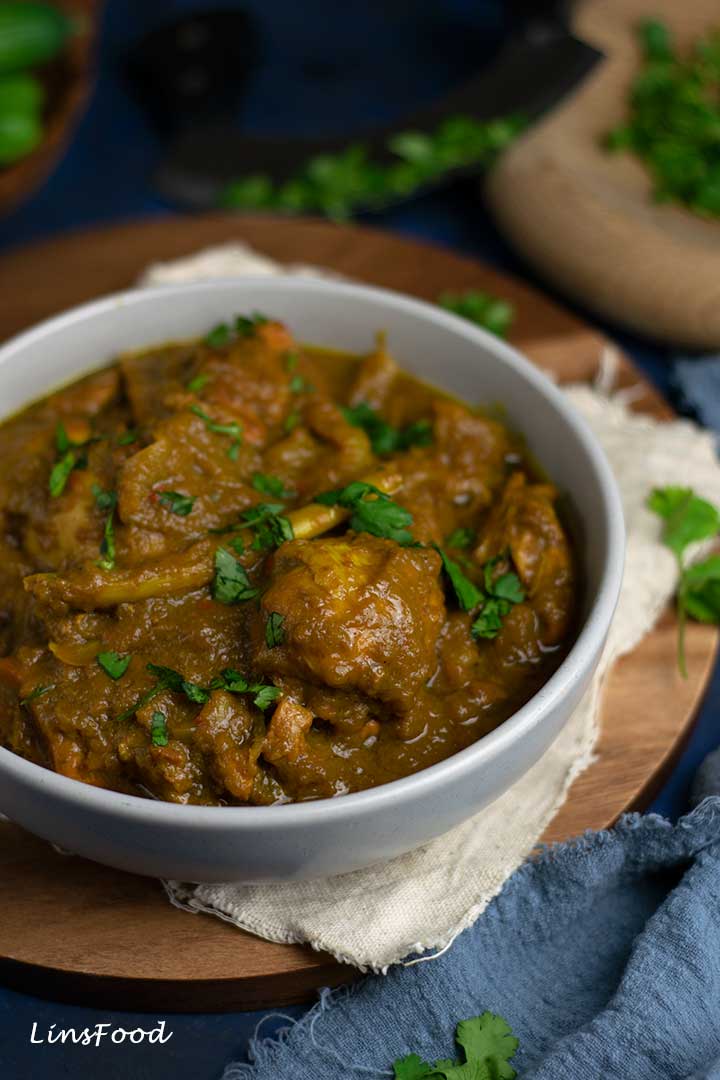
Cooking this Eurasian Curry
The curry itself is pretty easy to cook. The time it takes will depend on the size of your chicken portions and whether they are boneless or not. Chicken legs will take the longest, about 45 minutes.
My suggestion is to always you meat on the bone for curries, stews and soups. The bones add flavour to the dish.
This is what we’ll be doing:
- Soak the tamarind.
- Make the paste.
- Cook the curry. That’s it!
Ayam Assam Serani Ingredients
Depending on where in the world you are, some of the ingredients may not be the easiest to find. Let’s briefly take a look at them. You can go to the individual articles to read more about each ingredient.

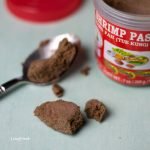
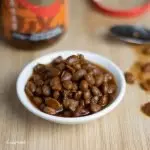
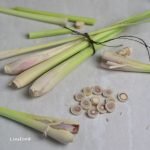
Tamarind
Tamarind is a souring agent used in many cuisines, so hopefully, it’s something you should be able to find, whether the pods themseles, in pulp form or ready-to-use paste.
If you really can’t get tamarind, the best substitute is clear vinegar. While lime and lemon juice are also souring agents, and can technically be used as tamarind substitutes as suggested by some sites, they will also impart their citrusy flavours to your dish. And that’s not always desirable, and I certainly think that our ayam assam serani is better off withut any citrus.
Click here to read more about tamarind.
Shrimp Paste (Belacan)
An essential ingredient in South East Asian cooking, belacan is dried, fermented tiny shrimps. The scream umami and add a salty depth to dishes.
If you can’t get it, skip it.
Click here to read more about belacan.
Salted Soy Beans (Taucheo)
Taucheo is definitely a specialist ingredient. These salted soy beans, along with the shrimp paste, are responsible for the depth of flavour in our ayam assam serani.
You will find them in East Asian (Chinese, Japanese, Korean) stores, and most definitely online. You can even use the Korean version for this, or dark miso paste. Click here to read more on taucheo and its substitutes.
Lemongrass (Serai)
I don’t think lemongrass is an elusive ingredient these days, do you? Certainly not here in the UK; all our bigger supermarkets will stock them, fresh, as well as in paste form.
Click here to read more about lemongrass and how to properly prepare it for use in recipes.
How to Serve this Eurasian Curry?
The best accompaniment will be plain white rice. Or brown, if that’s the way your boat rocks. This curry is so flavoursome, to me, a green salad is all I need to go with it.
However, you can always have a vegetable side dish to accompany it, if you fancy, like kangkung belacan or sambal goreng.
And now, shall we get cooking?
More Curries and Stews on SMR

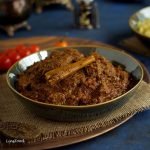

♥ If you like the recipe and article, don’t forget to leave me a comment and that all important, 5-star rating! Thank you! ♥
And if you make the recipe, share it on any platform and tag me @azlinbloor, and hashtag it #linsfood
Lin xx
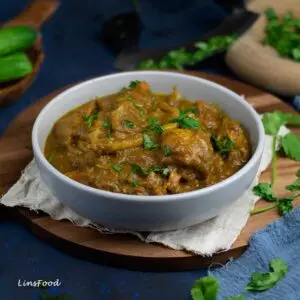
Ayam Assam Serani (Tangy Eurasian Chicken Curry)
Ingredients
- 1 kg chicken portions
- 1 large onion
- 2 stalks lemongrass
- 4 Tbsp tamarind pulp or sub with 1 Tbsp clear vinegar
- 250 ml hot water this is for the tamarind
- 2 Tbsp vegetable oil
- ½ tsp salt
- 1 tsp clear vinegar
- small handful fresh coriander
Paste Ingredients
- 2 large onions
- 1 lemongrass
- 2 fresh red chillies use more or a hotter variety for a spicy curry
- 1 tsp turmeric powder
- 1 Tbsp shrimp paste belacan – omit if unavailable
- 2 Tbsp taucheo (salted soy beans) if unavailable, use 1 Tbsp red/brown miso paste
Instructions
Soak the Tamarind (skip if using shop bought paste)
- Put the kettle on and place the tamarind pulp in a bowl.
- Pour about 250 ml (1 cup) of boiling water over the pulp and cover with a saucer. Leave to soak while you get the other ingredients going and get started with the cooking.The longer the tanarind soaks, the better, but with boiling water, a minimum of 10 minutes will do.
Prep Work
- Onions – you have 3 large onions. Slice one into rings and set aside on a plate until needed.Quarter the other 2 onions and place them in a chopper to make our cooking paste (called rempah in Malay).
- Lemongrass – you have 3. We'll be using 2 of them whole, the other is going in the paste. Slice off the tough bottom end (the root end) of the lemongrass stalks. And cut off the top part, leaving about 10 cm/4 inches of stalk. Peel off the top layer, if it's particularly dry or dirty, or looking a little yellow. If not, leave it alone. Rinse your lemongrass and dry.Whole – place 2 of the lemongrass stalks on a chopping board and bash hard on the thick end with the back of your knife. This is called bruising your lemongrass. Set aside until cooking time.Third lemongrass – slice into thin rings and add to the chopper.You can read more about how to prepare lemongrass for use in this post.
- Chop up your fresh coriander leaves (cilantro) and set aside until after the curry is done. You can place them in the fridge to retain their vibrancy, if you like. Or chop them up when the curry is done cooking – up to you.
- Let's get the paste (rempah) done.Slice the red chillies and add to the chopper.Add the turmeric, shrimp paste and taucheo to the chopper too.Chop everything to get a fine paste. You shouldn't need any water as there is enough moisture from the onions and taucheo.If your chopper isn't big enough, do it in 2 rounds.
Let's get Cooking
- Heat the oil in a large saucepan on medium high heat and sauté the onion rings for 1 minute.
- Add the lemongrass stalks and fry for 30 seconds, then add the paste and fry for 2 minutes until you get a strong aroma of the paste.
- Add all the chicken portions, and stir, to coat thoroughly with the spice paste.
- Mash the tamarind with your fingers (it should be cool enough now). Then fish out the seeds and pulp, discard, and pour everything else into your pan. Or use a sieve with a large mesh. Stir to mix.
- Add the salt, mix thoroughly and bring back to a boil. Lower the heat right down and simmer for 30-45 minutes until the chicken portions are fully cooked. The time will depend on the size of your chicken portions.
- When the chicken is fully cooked, add the vinegar, stir, then check the seasoning. It should be perfect, but add more salt, if you think it needs it. You should have a thick, dry curry with a full on flavour.If you like more sauce, add a little more water, perhaps 125ml (½ cup), stir, and bring back to a simmer. In this instance, you will need a little more salt.
- Scatter the fresh coriander (cilantro) and serve with rice.

